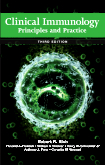Written and edited by international leaders in the field, this book has, through two best-selling editions, been the
place to turn for authoritative answers to your toughest challenges in clinical immunology. Now in full color and one
single volume, the 3rd Edition brings you the very latest immunology knowledge - so you can offer your patients the
best possible care. The user-friendly book and the fully searchable companion web site give you two ways to find the
answers you need quickly...and regular online updates keep you absolutely current.
Key Features
Leading international experts equip you with peerless advice and global best practices to enhance your diagnosis and
management of a full range of immunologic problems.
A highly clinical focus and an extremely practical organization expedite access to the answers you need in your daily
practice.
Table of Contents
PART 1: Fundamental Principles of the Immune Response
1 The human immune response
2 Organization of the immune system
3 Innate immunity
4 Antigen receptor genes, gene products, and co-receptors
5 The major histocompatibility complex
6 Antigens and antigen processing
7 Antigen-presenting cells and antigen presentation
8 B-cell development and differentiation
9 T-cell development
10 Cytokines and cytokine receptors
11 Chemokines and chemokine receptors
12 Lymphocyte adhesion and trafficking
13 T-cell activation and tolerance
14 Programmed cell death in lymphocytes
PART 2: Host Defense Mechanisms and Inflammation
15 Immunoglobulin function
16 Regulatory T cells
17 Helper T-cell subsets and control of the inflammatory response
18 Cytotoxic lymphocyte function and natural killer cells
19 Host defenses at mucosal surfaces
20 Complement and complement deficiencies
21 Phagocytes and phagocyte deficiencies
22 Mast cells, basophils and mastocytosis
23 Eosinophils and eosinophilia
PART 3: Infection and Immunity
24 Immune response to extracellular bacteria
25 Immune responses to intracellular bacteria
26 Immune responses to spirochetes
27 Immune responses to viruses
28 I mmune responses to protozoans
29 Immune responses to helminths
PART 4: Immunologic Deficiencies
30 Evaluation of the immunodeficient patient
31 Infections in the immunocompromised host
32 Development of the fetal and neonatal immune system
33 Aging and the immune system
34 Primary antibody deficiencies
35 Primary T-cell immunodeficiencies
36 Inherited disorders of IFN-γ-, IFN-α/β-, and NF-κB-mediated immunity
37 HIV infection and acquired immunodeficiency syndrome
38 Immunodeficiency due to congenital, metabolic, infectious,
surgical, and environmental factors
PART 5: Allergic Diseases
39 Pathogenesis of asthma
40 Management of the asthmatic patient
41 Rhinitis and sinusitus
42 Urticaria, angiodema, and anaphylaxis
43 Allergic reactions to stinging and biting insects
44 Atopic and contact dermatitis
45 Food allergy
46 Eosinophil-associated gastrointestinal disorders (EGID )
47 Allergic disorders of the eye
48 Drug hypersensitivity
49 Occupational and environmental allergic disorders
PART 6: Systemic Immune Diseases
50 Mechanisms of autoimmunity
51 S ystemic lupus erythematosus
52 Rheumatoid arthritis
53 Juvenile idiopathic arthritis
54 Sjögren’s syndrome
55 Systemic sclerosis
56 Inflammatory muscle diseases
57 Spondyloarthritis
58 Small- and medium-vessel primary vasculitis
59 Large-vessel vasculitides
60 Autoinflammatory fever syndromes
61 Antiphospholipid syndrome
PART 7: Organ Specific Inflammatory Disease
62 Immunohematologic disorders
63 Bullous diseases of the skin and mucous membranes
64 Myasthenia gravis
65 Multiple sclerosis
66 Autoimmune peripheral neuropathies
67 Immunologic renal diseases
68 Inflammation and atherothrombosis
69 Autoimmune thyroid diseases
70 Diabetes and related autoimmune diseases
71 Immunologic lung diseases
72 Sarcoidosis
73 Immunologic ocular disease
74 Immunologic disease of the gastrointesinal tract
75 Inflammatory hepatobiliary cirrhosis
PART 8: Neoplasia and the Immune System
76 Lymphoid leukemias
77 Lymphomas including Hodgkin lymphoma
78 Monoclonal gammopathies
79 Tumor immunology and immunotherapy
PART 9: Transplantation
80 Concepts and challenges in transplantation: rejection,
immunosuppression and tolerance
81 Challenges and potentials of xenotransplantation
82 Hematopoietic stem cell transplantation for malignant diseases
83 Stem cell transplantation and immune reconstitution
in immunodeficiency
84 Thymic reconstitution
PART 10: Prevention and Therapy of Immunologic Diseases
85 Immunoglobulin therapy: replacement and immunomodulation
86 Gene transfer therapy of immunologic diseases
87 Glucocorticoids
88 Nonsteroidal anti-inflammatory drugs
89 Antihistamines
90 Immunomodulating pharmaceuticals
91 Protein kinase antagonists as therapeutic agents for immunological
and inflammatory disorders
92 Vaccines
93 Immunotherapy of allergic disease
94 Cytokine therapy
95 Monoclonal antibodies and fusion proteins
PART 11: Diagnostic Immunology
96 Assessment of proteins of the immune system
97 Flow cytometry
98 Assessment of functional immune responses
99 Assessment of neutrophil function
100 Assessment of human allergic diseases
101 Molecular methods
Apendices
1 Selected CD molecules and their characteristics
2 Laboratory reference values
3 Chemokines
4 Cytokines


